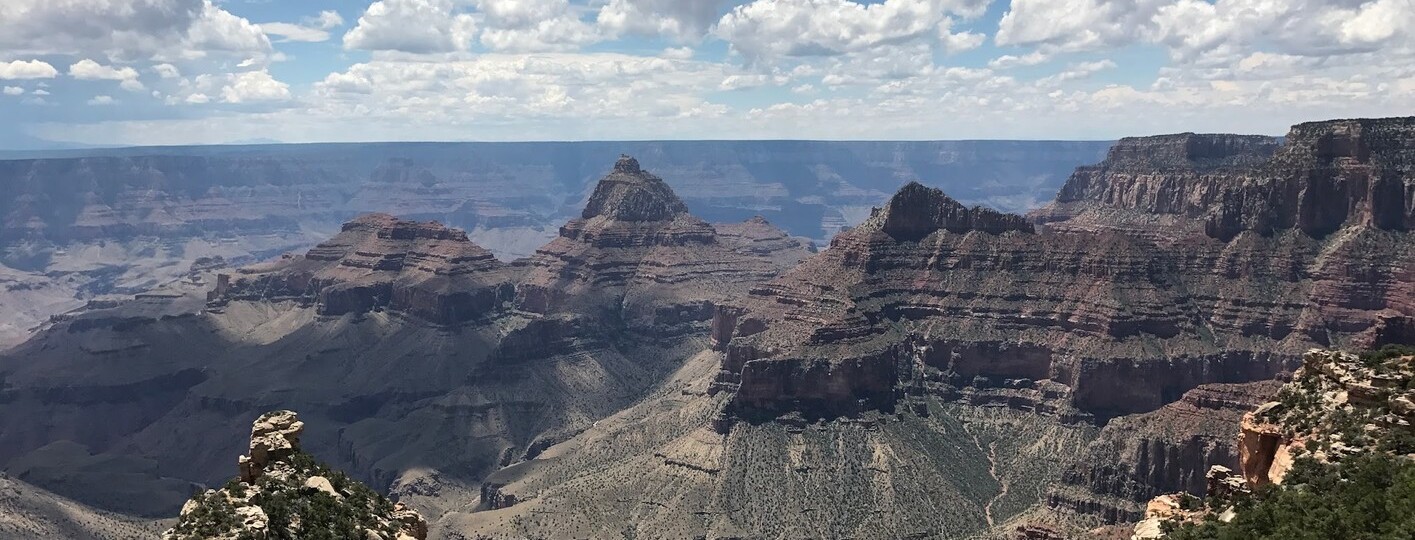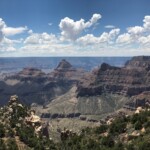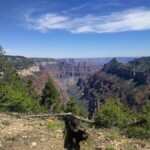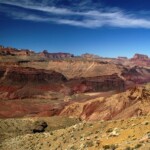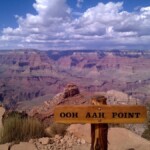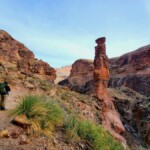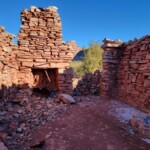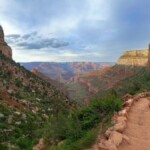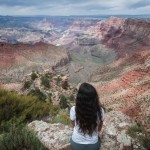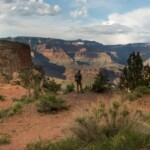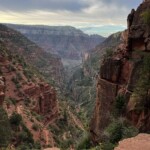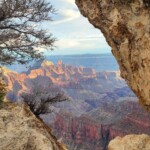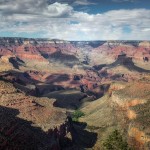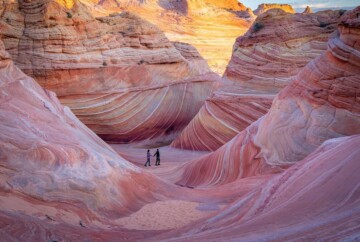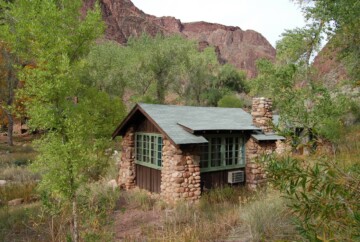Embarking on a Grand Canyon hike is the best way to truly experience the breathtaking landscapes and beauty of this natural wonder. The region’s unique conditions preserve the colorful rocks remarkably well, so each hike is a fascinating journey through history and nature.
Most Grand Canyon trails are unpaved, unshaded, and often steep and narrow, but I always believe the challenge is part of the adventure. Of course, there are differences between the South Rim vs. North Rim, but I can assure you that hiking on either rim will be one of the most memorable experiences of your life.
This guide to hiking in the Grand Canyon will cover the top 10 trails you shouldn’t miss. I will provide details about each trail’s difficulty level, distance, elevation change, and key highlights along the way. To make the most of your journey, be sure to check out our tips for visiting the Grand Canyon as well.
1. Grand Canyon Rim Trail, one of the best trails in the Grand Canyon
No visit to the South Rim is complete without enjoying the famous Grand Canyon Rim Trail. It’s a 12.7-mile point-to-point trail, which takes around 4.5 hours to complete. Known for its moderate difficulty, it’s a favorite among hikers and runners. It’s also one of the most accessible and dog-friendly hikes in the Grand Canyon, so expect to encounter fellow hikers along the way.
The Rim Trail in the Grand Canyon is mostly paved and has mile markers to help you easily navigate the path. While there are no water sources directly on the trail, you’ll find shaded spots in Grand Canyon Village, where you can take a moment to catch your breath.

1. Grand Canyon Rim Trail, one of the best trails in the Grand Canyon
Hiking the entire trail may be a bit challenging, but you can hike just a section, hopping on the free shuttle buses that travel parallel to the rim. It’s up to you where you stop, although my recommendations on the best Grand Canyon viewpoints may help you choose. My favorite section of the trail is the 2-mile trek from Hermit’s Rest to Monument Creek Vista, also known as the Hermit Road Greenway, which takes less than an hour.
Alternatively, you can enjoy a 20-minute walk from Mather Point to Yavapai Point, which is one of the most crowded segments of the Rim Trail in the Grand Canyon, together with the Trail of Time section that passes Yavapai Point.
- Duration: 4-5 hours
- Distance: 12.7 miles
- Difficulty: Moderate
- Route type: One-way
- Obstacles: Mostly paved and well-maintained, but can be crowded in the most popular sections.
- Elevation change: 583 ft
- When to go: Year-round
2. Bright Angel Trail, one of the most challenging hikes in the Grand Canyon
The Bright Angel Trail is the most popular route for hiking into the Grand Canyon and down to the Colorado River. Spanning nearly 16 miles round-trip, this trail is known for its challenging terrain and steep climb back up, so it’s best for experienced hikers.
This Grand Canyon trail is open year-round and provides some shaded spots in the morning and afternoon, along with amenities like vault toilets along the way. You can find drinking water year-round at Havasupai Gardens (4.5 miles from the trailhead) and from May to October at the two resthouses along the route (1.5 miles and 3 miles from the trailhead).

2. Bright Angel Trail, one of the most challenging hikes in the Grand Canyon
If you don’t want to hike all the way to the Colorado River, you can take a side trip from the Bright Angel Trail to the Plateau Point trailhead and continue to Plateau Point, where you can admire one of the most stunning views of the canyon. Many hikers do it in one day, but it’s 12 miles round-trip, so I recommend getting a permit to camp at Havasupai Gardens.
From my experience, I recommend taking one day for the hike down to the bottom of the Grand Canyon and another day for the hike back up. This is a popular destination, so it’s best to plan well in advance and get a reservation at Phantom Ranch, one of the best cabins at the Grand Canyon. Or, you can opt for camping at the South Rim at the Bright Angel Campground by the Colorado River. I’ll explain more about the overnight permits and reservation process at the end of this article.
Whether you’re doing a short hike or taking a multi-day adventure, avoid hiking during the scorching summer months and try to start early to beat the heat, especially with the strenuous climb on the way back up. And don’t forget to bring snacks and wear proper footwear to ensure a safe and enjoyable hike.
- Duration: 4-5 hours going down and 7-8 hours going up
- Distance: 8 miles (one way)
- Difficulty: Strenuous
- Route type: Can be combined with the North Kaibab Trail to hike rim-to-rim or used as an out-and-back trail
- Obstacles: Long distance, steep ascent on the way back, and potential hazards like severe weather, overexertion, and dehydration.
- Elevation change: 4,478 ft
- When to go: Spring and fall
3. South Kaibab Trail, one of the longest Grand Canyon hiking trails
The South Kaibab Trail, which starts near Yaki Point, offers a breathtaking hike down to the Grand Canyon. To reach the trailhead, you’ll need to take the eastbound Kaibab Rim (Orange) Route shuttle since this viewpoint is closed to private vehicles.
The trail, renowned for its dramatic exposure to the canyon’s vastness, provides little shade and no water, so you must pack accordingly. Despite being less crowded than the Bright Angel Trail, it’s still one of the most popular trails in Grand Canyon National Park.
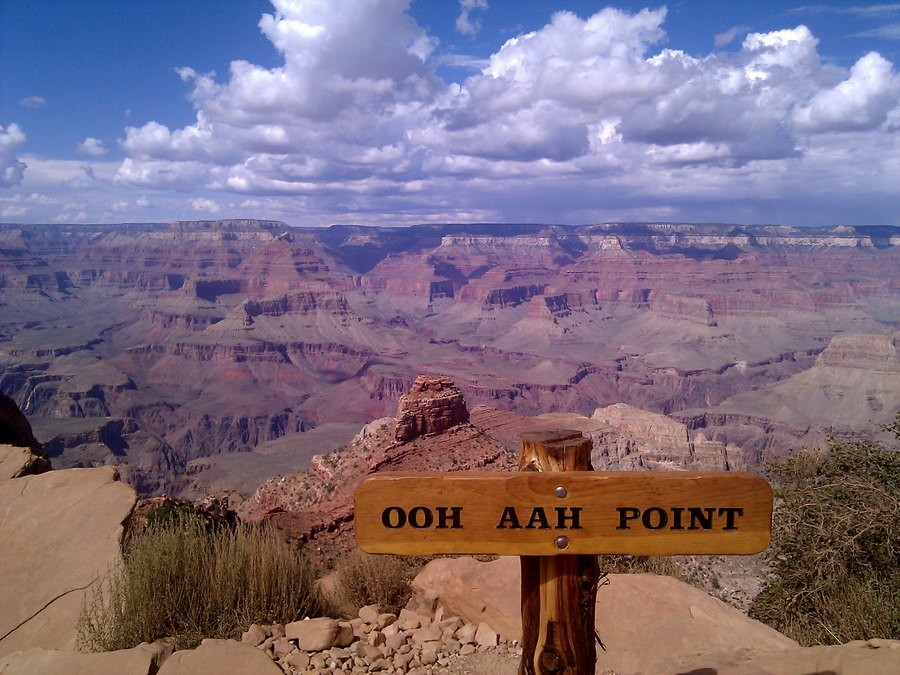
3. South Kaibab Trail, one of the longest Grand Canyon hiking trails
The South Kaibab Trail is nearly 7 miles one-way, but you can choose Ooh-Aah Point (0.6 miles from the trailhead), Cedar Ridge (1.3 miles from the trailhead) or Skeleton Point (2.8 miles from the trailhead) as your turnaround point. If you decide to hike to the Colorado River, it’s a smart idea to stay overnight at Phantom Ranch or Bright Angel Campground. In fact, most hikers get back to the South Rim via the Bright Angel Trail, or even connect with the North Kaibab Trail to complete the Rim-to-Rim Trail.
Something I loved about hiking down the South Kaibab Trail is that it’s a great route for observing animals in the Grand Canyon like California condors, mule deer, rock squirrels, and various birds of prey.
- Duration: 4-5 hours going down and 7-8 hours going up
- Distance: 6.8 miles (one way)
- Difficulty: Strenuous
- Route type: Can be combined with the North Kaibab Trail to hike rim-to-rim. If you prefer to get back to the South Rim, it’s easier to do it via the Bright Angel Trail, but you can use the South Kaibab Trail as an out-and-back route
- Obstacles: Long distance, very little shade, steep ascent on the way back, and potential hazards like severe weather, overexertion, dehydration and wildlife encounters.
- Elevation change: 4,734 ft
- When to go: Spring and fall
4. North Kaibab Trail, one of the best day hikes in the Grand Canyon
The North Kaibab Trail is one of the least visited and most challenging trails in Grand Canyon National Park. Spanning approximately 28 miles round trip, this trail takes you from the North Rim to the canyon’s depths, where you can appreciate breathtaking views of the Colorado River.
If you’re planning to tackle the entire trail, you must split the hike into at least two days so you can enjoy the journey down on one day and the return ascent the next morning after a restful night at Phantom Ranch or Bright Angel Campground. This Grand Canyon hike to the Colorado River requires about 6 hours to cover roughly 14 miles one-way, with a dramatic 5,800-foot elevation change, so it’s suitable only for seasoned hikers.
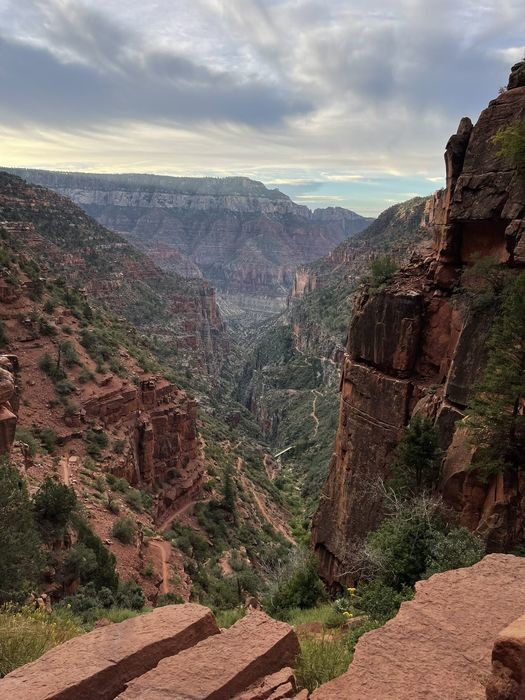
4. North Kaibab Trail, one of the best day hikes in the Grand Canyon
As you descend, you’ll pass through diverse ecosystems, enjoying one of the most scenic hiking trails in the North Rim. Don’t worry if the entire trail seems too much. There are several great spots where you can turn around, including Coconino Overlook (0.7 miles from the trailhead), Supai Tunnel (2 miles from the trailhead), Roaring Springs (4.7 miles from the trailhead), and Cottonwood Campground (7.8 miles from the trailhead).
The North Rim is only open between May and November, but I don’t recommend hiking this trail during the hot summer months, even if you’re planning to start early. The best time to go is at the beginning or end of the open seasons, when weather conditions are more favorable.
- Duration: 6-7 hours going down and 8-10 hours going up
- Distance: 14.1 miles (one way)
- Difficulty: Strenuous
- Route type: Can be combined with the Bright Angel Trail or South Kaibab Trail to hike rim-to-rim, or used as an out-and-back trail.
- Obstacles: Long distance, steep ascent on the way back up, rocky terrain, some scrambling, no shade.
- Elevation change: 5,850 ft
- When to go: May through November (avoid the summer months)
5. Hermit Trail, one of the most beautiful Grand Canyon trails
The Hermit Trail is a 17-mile out-and-back trek, and it’s one of the best hikes in the Grand Canyon. The trailhead is located at the end of Hermit Road, near Hermit’s Rest, one of the most spectacular views of the Grand Canyon South Rim. You can access the trailhead by Hermit (Red) Route shuttle from Grand Canyon Village, running from March 1 to November 30. The first shuttle departs at 8:00 am, with the last outbound bus leaving the Village at 7:00 pm. Hermit Road is closed to private vehicles, except in winter when there is no bus service.
The Hermit Trail at the Grand Canyon descends 2,000 feet in the first 2.5 miles via switchbacks through the Kaibab Formation and Coconino Sandstone, where you can see fossilized tracks. Key points along the trail include Waldron Basin at 1.2 miles, the Waldron and Dripping Springs Trail junctions, and Santa Maria Spring at 2.5 miles, where you can refill your water bottles and get some rest. Just remember that water from the springs must be purified before drinking, so either bring enough water for the entire hike or carry a high-quality filter with you.
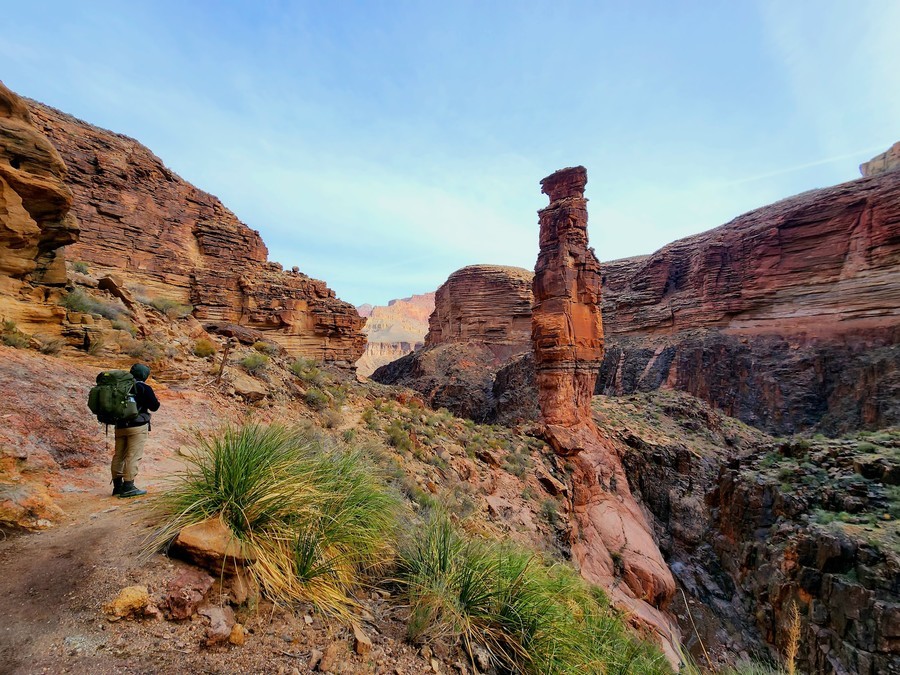
5. Hermit Trail, one of the most beautiful Grand Canyon trails
We enjoyed this trail in early October when the weather was perfect. We decided to hike to Lookout Point, nearly 4 miles from the trailhead. It took us 5 hours to get there, snap some amazing photos, and return in time to catch the last bus back to the Village. It was definitely one of the best hikes in the Grand Canyon.
Remember, you’ll need a backcountry permit for camping at Hermit Creek (BM7, toilet on site) and Hermit Rapids (BM8, no toilet), which are the only designated campsites in the Hermit Use Area. You can obtain the permit on the park’s website or in person at the Backcountry Information Center.
- Duration: 4-5 hours going down and 6-7 hours going up
- Distance: 8.5 miles (one way)
- Difficulty: Strenuous
- Route type: Out-and-back
- Obstacles: Long distance, rocky, some scrambling, very little shade.
- Elevation change: 5,000 ft
- When to go: Spring and fall
6. Grandview Trail, one of the best Grand Canyon trails for backpacking and camping
The Grandview Trail offers one of the best hikes in the Grand Canyon, spanning nearly 5.6 miles out and back. This trail was originally constructed to link the rim with the copper mines on Horseshoe Mesa. In fact, you can still see remnants of past mining operations, but be careful to leave everything as you find it to preserve the history of this trail.
The trailhead is located at Grandview Point, about a 15-minute drive east of the Grand Canyon Visitor Center at the South Rim, on Desert View Scenic Drive. From there, you’ll traverse steep slopes and some eroded sections where a fall could be catastrophic, so be extra careful, especially during winter when the surface is icy or wet.
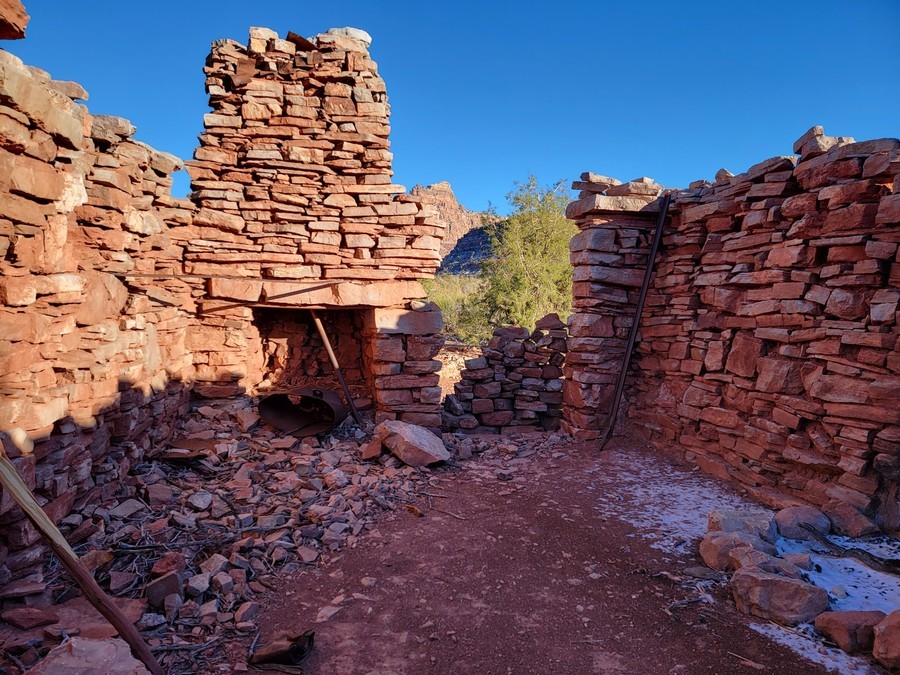
6. Grandview Trail, one of the best Grand Canyon trails for backpacking and camping
While it’s considered one of the best short hikes in the Grand Canyon with fewer visitors compared to other trails and beautiful scenery in every season, it’s also one of the most challenging. Most sections of the trail are rocky, exposed, and strenuous, and feature big steps and steep pitches, which makes it suitable only for experienced desert hikers.
It’s totally doable in one day. However, if you’re planning to camp at Horseshoe Mesa (BF5), make sure to get the permit online or in person at the Backcountry Information Center. Also, keep in mind that there is no drinking water available on the trail, so bring enough water for the return journey as well.
- Duration: 5-6 hours
- Distance: 5.6 miles
- Difficulty: Hard
- Route type: Out-and-back
- Obstacles: Long distance, rocky, some scrambling, no shade.
- Elevation change: 2,500 ft
- When to go: Spring and Fall
7. Widforss Trail, a popular Grand Canyon trail with stunning landscapes
The Widforss Trail is one of the best easy trails in the Grand Canyon, covering approximately 9 miles round-trip. This trail is named after Gunnar Widforss, an American artist famous for his landscape paintings of the canyon. It starts at the Widforss Trailhead and parking lot, about 1.5 miles from the North Rim Backcountry Information Center. From there, the route winds through a lush forest before emerging at Widforss Point, a narrow, wooded promontory.
The terrain is fairly manageable, with moderate elevation changes, making it one of the easiest hikes in the Grand Canyon. While the trail starts with a steep climb, it quickly levels out, with only a few gentle ups and downs afterward. Most of the hike is shaded by trees, which helps keep you cool. However, there are no water sources along the trail, so make sure to bring enough water.
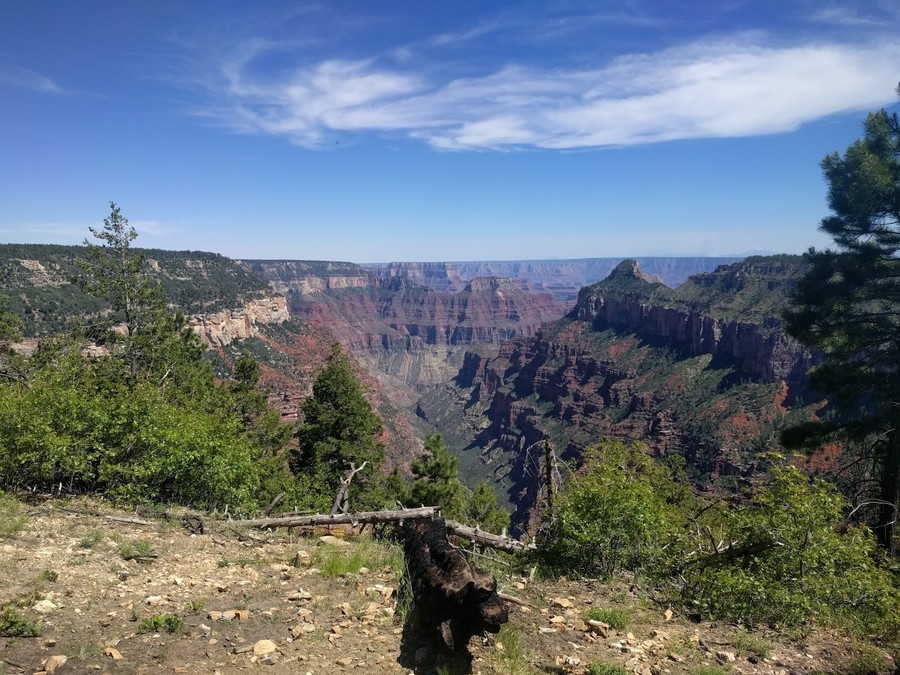
7. Widforss Trail, a popular Grand Canyon trail with stunning landscapes
You don’t need to hike the full 4.5 miles to enjoy the trail’s beauty. Even a 1.5-mile hike is enough for soaking in the great views of Transept Canyon and beyond. We hit the trail early in the morning when it was quiet and a bit chilly, with hardly any other hikers around, and we loved it. All we could hear were birds and the crunch of our own footsteps, with the aroma of pine filling the air.
The Widforss Trail is one of the most popular hikes in the Grand Canyon among nature enthusiasts as well. Along the way, you might spot deer, horned toads, butterflies, and grasshoppers. So, don’t miss it!
- Duration: 4-5 hours
- Distance: 9 miles
- Difficulty: Moderate
- Route type: Out & back
- Obstacles: Long distance.
- Elevation change: 1,000 ft
- When to go: May through October (North Rim is closed in the winter)
8. Cape Final Trail, one of the easiest hikes in the Grand Canyon
The Cape Final Trail is a 4-mile out-and-back trail, offering one of the easiest Grand Canyon hikes that everybody can enjoy. You’ll find the trailhead after driving 30 minutes along the North Rim Scenic Drive.
The trail begins with a rocky path entirely within the forest. About halfway through, you’ll start to catch glimpses of the Grand Canyon through the trees, hinting at the stunning views to come.

8. Cape Final Trail, one of the easiest hikes in the Grand Canyon
With gentle terrain and lots of shade along the path, it definitely ranks among the best Grand Canyon hikes for families. The trail ends at Cape Final, one of the most spectacular viewpoints in the North Rim, where you’ll be rewarded with sweeping canyon vistas in three directions.
An overnight stay isn’t necessary, but if you’re lucky enough to get the backcountry permit, you can camp at the only campsite at Cape Final, which I imagine is lots of fun. Even if you’re not camping, this hike is still one of the best things to do at the North Rim. So, make sure to enjoy the solitude and serenity along this short hike in the Grand Canyon.
- Duration: 1-2 hours
- Distance: 4 miles
- Difficulty: Easy
- Route type: Out & back
- Obstacles: Parts of the trail are rocky.
- Elevation change: 500 ft
- When to go: May through October (North Rim is closed in the winter)
9. Tanner Trail, one of the most difficult Grand Canyon hikes
The Tanner Trail is a 14.3-mile out-and-back hike, starting at Lipan Point, another beautiful lookout on Desert View Drive. It ends at the Tanner Rapids of the Colorado River. This route is known as one of the most challenging hiking trails in the Grand Canyon, so I don’t recommend it to first-time canyon visitors or anyone looking for a day hike in the Grand Canyon.
Since at-large camping is allowed at the Tanner Canyon Use Area (BB9), I suggest getting a backcountry permit and staying overnight. There are several dry campsites at 75 Mile Creek-Tanner Canyon Saddle, at the Supai Formation, above and below the Redwall Limestone, and at the Tapeats Sandstone. You’ll also find campsites on the east side of Tanner Canyon, by the river, with composting toilets.
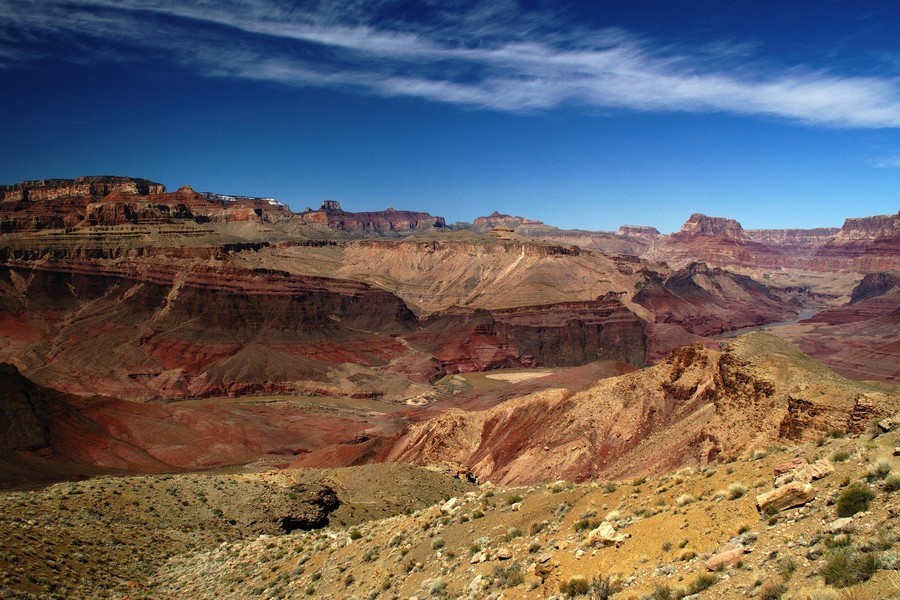
9. Tanner Trail, one of the most difficult Grand Canyon hikes
Just bear in mind that you should bring all the water you’ll need since there are no water sources besides the Colorado River, and this water can be difficult to purify since it usually contains lots of silt. Also, the summer heat is insane here, and the lack of shade and sparse vegetation add to the difficulty. So, while it’s one of the best trails at the South Rim, it’s a good idea to check with a park ranger to make sure conditions are right and you’re ready for the trek.
If you have experience with long multi-day hikes, you may want to continue your trip through the inner canyon, connecting west along the Escalante Route and getting back to the rim through the New Hance Trail (27 miles in total plus a 10-minute hitchhike ride back to your car). You could even connect east with the Beamer Trail to see the blue Little Colorado River (32 miles in total).
- Duration: 3-4 hours going down and 7-8 going up
- Distance: 7.1 miles (one way)
- Difficulty: Strenuous
- Route type: Out-and-back, but most hikers do variations of this trail, connecting with the Escalante Route or the Beamer Trail.
- Obstacles: Long distance, rocky, some scrambling, no shade.
- Elevation change: 5,416 ft
- When to go: Spring and Fall
10. Rim-to-Rim: North Kaibab to Bright Angel Trail, the most famous Grand Canyon trail
The Rim-to-Rim Trail is probably the most iconic hike in the Grand Canyon. It typically refers to the trek from the South Rim to the North Rim or vice versa. It’s a challenging journey that requires experience, planning, and preparation, but sure enough, you’ll be able to cross off a major item from your bucket list.
You can hike from the Grand Canyon South Rim to North Rim via different trails. The most popular route is from the North Kaibab Trail at the North Rim to the Bright Angel Trail at the South Rim; this is the easiest way to do it. However, there are many other combinations, such as the North Kaibab-South Kaibab Trail or going down the South Rim and up the North Rim (which is much harder due to the North Kaibab Trail’s greater length and elevation change). Anyway, whichever way you go, this trail is one of the best things to do at the Grand Canyon.
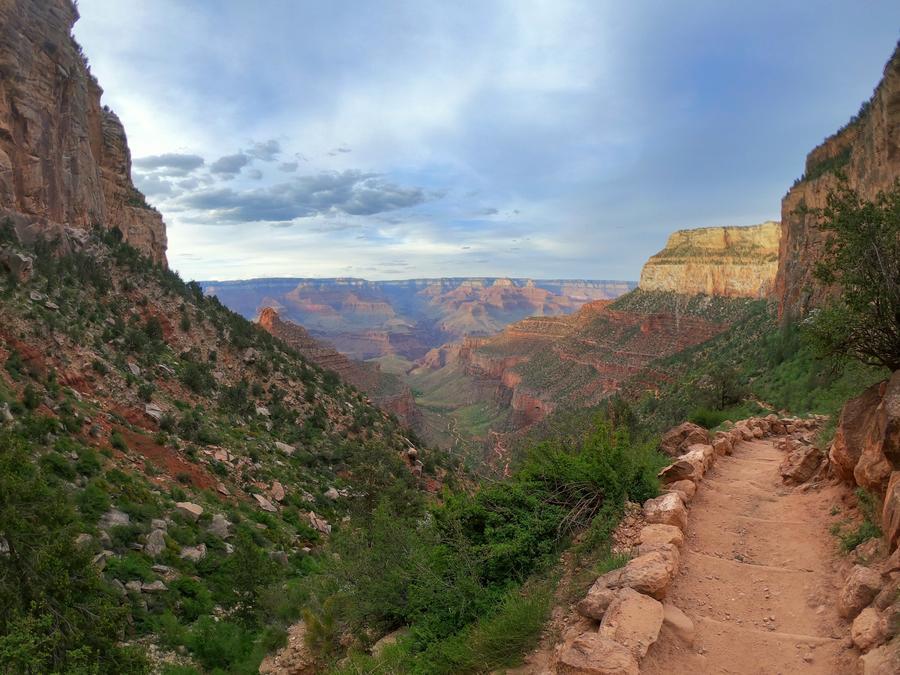
10. Rim-to-Rim: North Kaibab to Bright Angel Trail, the most famous Grand Canyon trail
While you can complete the Grand Canyon Rim-to-Rim hike in one day, it’s best (and safer) to spread it over several days. We did it as a 3-day hike, so we were able to enjoy a rest day in the middle of the journey to explore the bottom of the canyon. We stayed at Phantom Ranch, but reservations must be made 15+ months in advance. If you’re late, you can also try to get a backcountry permit to camp at Bright Angel Campground, but camping in the Grand Canyon is pretty popular, and spots fill up quickly.
Regarding logistics, we left our car parked at the South Rim and took a Rim-to-Rim shuttle bus the day before our hike. It takes 4 hours to get to the North Rim by car, so I recommend taking the 8:00 am shuttle if you want to explore a little bit in the afternoon. There are several companies that provide this service, and you can find them here (look for “Rim to Rim” as the location). Most of them charge around $120 per person, but having your car waiting for you at the end of the Rim-to-Rim Trail is a godsend!
- Duration: Multi-day
- Distance: 24.6 miles total (North Kaibab – Bright Angel Trail)
- Difficulty: Strenuous
- Route type: Linear
- Obstacles: Steep terrain, potential extreme weather, long-distance hike, limited water sources, rocky terrain, some scrambling, no shade.
- Elevation gain: 5,850 ft
- When to go: May through October (North Rim is closed in the winter)
Grand Canyon trails map
Below, I’ve included a map of the Grand Canyon hiking trails mentioned in this guide. You can also locate some of the main backcountry campsites along these trails.
For more help, check out our Grand Canyon maps.
How to get a backcountry permit for multi-day Grand Canyon hikes
If you’re planning a multi-day hike in Grand Canyon National Park, you’ll need a backcountry permit. Otherwise, the only places you can camp without a permit are the three developed campgrounds at the rims: Mather Campground, Desert View Campground, and North Rim Campground.
Each backcountry permit is for a specific use area, date, and number of people. The overnight capacity of each use area is based on the size of the area, the number of suitable and available campsites (designated sites or at-large), and any environmental precautions and preservation efforts. Getting a backcountry permit for some use areas is easier, but the most popular ones, like the backcountry permits for Bright Angel Campground (CBG), are in high demand and difficult to get. You can find the full list of use areas here.
To improve your chances of getting a permit for the use area you’re interested in, apply online for the early access lottery here during the two-week period ending on the 1st, four months before your desired start date. For example, if you want to start your multi-day hike any day in October, apply to the early access lottery during the two-week period ending on June 1st.
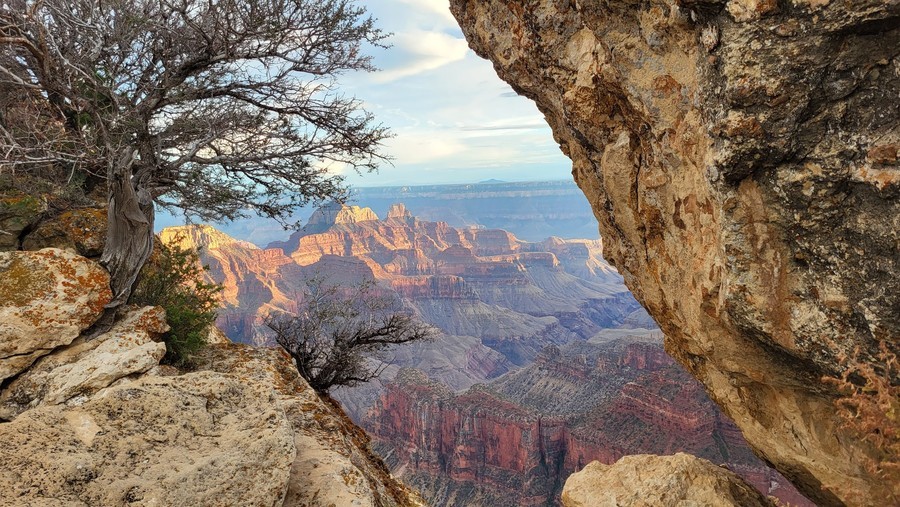
How to get a backcountry permit for multi-day Grand Canyon hikes
The following day, 750 winners will be notified and assigned a date and time within the first half of that month to log into their recreation.gov account, check availability, and pay for their reservation. The remaining camping spaces are available to the rest of the lottery applicants during the second half of that month and to everyone else starting on the 1st of the following month, which is three months before the hiking start date.
The price of the backcountry permit is $10 per permit or lottery application, plus a nightly charge of $15 per person for all below-rim areas ($4 per person for all above-rim areas). The lottery/basic permit fee is non-refundable. The per-person nightly charge is refundable until 30 days before the permit start date.
You can find more information on length of stays, group sizes, North Rim winter use, and last-minute reservations (only for Havasupai Gardens and Cottonwood Campground) here.
Also, remember that no backcountry permit is needed to stay at Phantom Ranch, but spots are allocated through this 15-month advance lottery due to high demand.
Additional tips for hiking in the Grand Canyon
Now that you know the essentials, let’s review a few tips for hiking in the Grand Canyon:
- Prepare for the park’s typically hot and dry conditions by wearing loose-fitting, light-colored clothing and sturdy hiking boots or shoes.
- Don’t forget sunglasses, a hat, and sunscreen to protect yourself from the sun.
- Carry plenty of water and snacks, as there is little shade along most routes, and some trails lack water stations.
- Download a map of Grand Canyon trails on your phone so you can access it even without cell service.
- Be mindful of mule crossings and give them the right of way on the trails.
- Start your hike early to take advantage of cooler morning temperatures and ample daylight.
- Avoid attempting long hikes in one day; it’s safer and more enjoyable to split them into multi-day adventures.
- Inform someone of your hiking plans, including your expected return time, in case of emergencies.
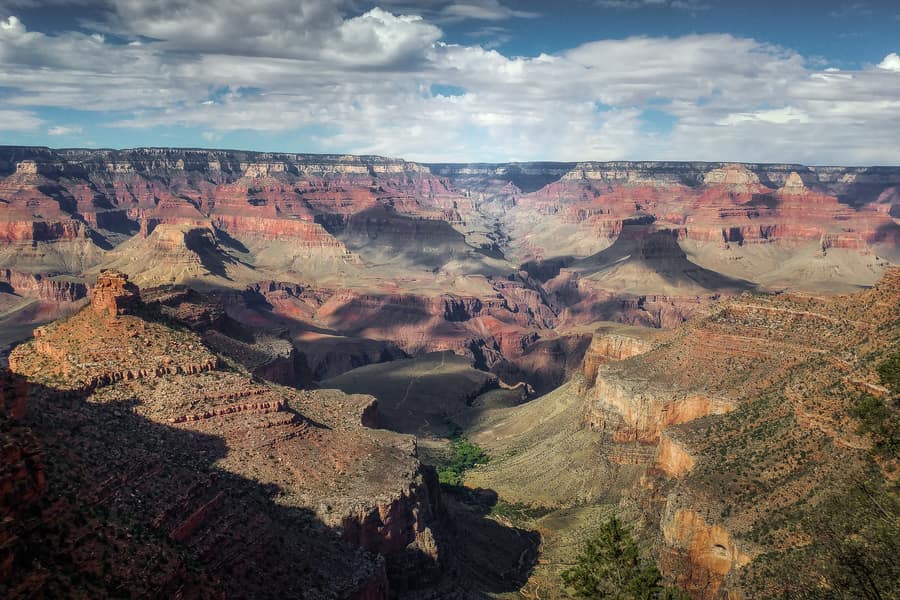
Additional tips for hiking in the Grand Canyon
- For long out-and-back hikes, consider leaving hidden water caches along your route so you’ll have water on your way back. This way, you won’t have to carry all that water with you.
- For multi-day hikes, make sure you know where to find reliable drinking water sources along the trail, if any. They are scarce on most trails, and the Colorado River water is difficult to treat. Here you can find the best disinfection procedures.
- Check trail conditions and weather forecasts before starting your hike, as trails can be impacted by rockslides, weather, and maintenance work, especially if you’re visiting the Grand Canyon in winter. You can also check out the latest updates with park rangers.
- Include a basic first aid kit on your Grand Canyon packing list, with items like band-aids, antiseptic wipes, pain relievers, and any personal medications.
- Plan a comprehensive itinerary and take into account Grand Canyon entrance fees and Grand Canyon operating hours.
- When planning an overnight hike in the Grand Canyon, ensure you have appropriate gear such as a tent, sleeping bag, and enough food to sustain you for the duration.
- For winter hiking in the Grand Canyon, dress in layers, and bring traction devices for icy trails.
- And finally, remember some Grand Cayon hikes are extremely demanding. Choose trails that match your fitness and experience level to ensure a safe hike.
FAQs – Hiking in the Grand Canyon
Now that you’re familiar with the best Grand Cayon hikes, let’s address some of the most frequently asked questions.
And that wraps up the best hikes in the Grand Canyon! I hope you find this information useful for your next trip to the national park. If you have any questions or want to share your own experiences, feel free to leave a comment below. I’d love to hear from you.
Safe travels!
